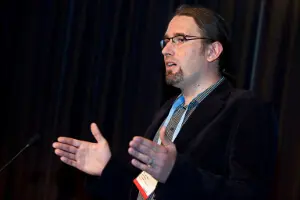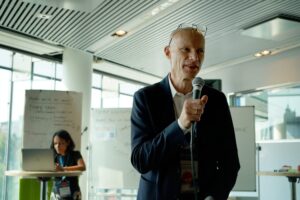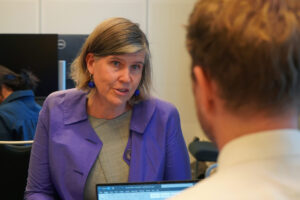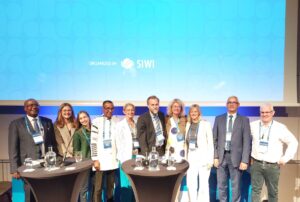Cleaning up Corrupted Water – Enabling Mechanisms for Improved Water Integrity, 2010 Stockholm World Water Week
On September 5, during 2010 World Water Week in Stockholm, the UNDP Water Governance Facility together with the Water Integrity Network and the International Union for Conservation of Nature (IUCN) organized a seminar entitled Cleaning up Corrupted Water - Enabling Mechanisms for Improved Water Integrity.
The seminar, chaired by Dr Letitia Obeng from the Global Water Partnership, sought as the first of its kind to define the often overlooked link between water pollution and corruption and to clarify ways to reduce illegal water pollution through improved integrity transparency and accountability. Options that were discussed included the policy, legal and institutional frameworks needed to make compliance and enforcement effective, particularly in a corruption prone environment where resources and capacity often are constrained. The seminar also looked at different regulatory incentive systems in place to promote integrity and compliance to standards by polluters as well as the role of civil society and private sector in reducing water pollution corruption.
Summary
In many parts of the world, water pollution is a rapidly growing problem. It is one of the leading causes of premature deaths and diseases and environmental degradation. The extent and nature of the problem differ drastically, not only between countries but also within countries. While the underlying causes vary, poor governance of water resources is a major contributing factor. Experience has taught us that institutions with poor governance systems provide the breeding grounds for corruption.
In his keynote presentation Martin Hojsik from Greenpeace International provided a broad overview of water pollution and corruption. The common denominator was that corruption thrives when there is no or very limited public access to information and officials are not held responsible for their deeds, i.e. there is a lack of transparency and accountability. Measures to reduce water pollution corruption includes (i) a shift in legislation to aim at water pollution elimination, not management (ii) full implementation of polluter pays principle, (iii) mandatory transparency of supply chain of products which allows consumers to trace products to their origin (iiii) transparent collection of fees and more.


Dr Alejandro Iza, IUCN, Serious audience at the seminar
Dr. Alejandro Iza, from the IUCN Environmental Law Centre addressed the question of what enabling policy, legal and institutional frameworks that is required to strengthen governance capacity and to make compliance and enforcement effective. The starting point is a well articulated water policy that is consistent with the country’s overall development strategy. This provides the basis for the legal framework for water use and quality as well as the functioning of water sector institutions. These institutions need to be designed to carry out many different functions, such as: planning and coordination; fostering public participation; building, operating and maintaining water works; administering water rights; ensuring compliance and enforcement. While a regulatory system with adequate penalties is an integral part of the legal and institutional framework, it needs to be complemented by an appropriate enabling environment built on the basic principles of certainty, transparency and accountability.
The design of regulatory systems to promote integrity and compliance was the topic of two presentations by Dr. Michelle Perez from the World Resources Institute. The main approach is to limit discharge through technology-based or water quality-based regulatory standards. These provide little incentive for polluters to achieve more than required by the standard. However, the cost of removing pollutants can be very different depending on the source and the technology used. Thus, incentive-based systems can be quite effective in reducing water pollution. These can rely on conventional economic instruments such as taxes, fees, charges, or on market-based mechanisms such as nutrient trading to control pollution. There is also scope for greater use of “persuasive instruments” such as voluntary agreements between government & firms and good company certification programs. In this connection, one listener questioned whether governments had the detailed knowledge needed to create sound environmental standards. Another noted that in setting standards, regulators needed to face reality—i.e. what citizens and corporations can afford.
Both economic and marked-based regulatory instruments pose corruption risks, since they require considerable administration, monitoring, & enforcement. Developing countries are particularly vulnerable to these risks, since their institutional, technical and human capacities often are constrained.
Corruption can be initiated either by the regulated entities to influence water quality laws or regulations or to evade regulations or be initiated by regulators & politicians for political or private motives. These risks can be mitigated by; an effective regulatory framework to work within; well-designed standards; an effective regulatory agency to verify & enforce standards; effective monitoring network to detect changes in water quality; an interested civil society & media to keep the pressure on the polluters & the regulatory agency.
Agriculture is often the major source of water pollution. Reducing run-off of nutrients and sediments requires that thousands, if not millions, of farmers change their cultivation practices. This calls for a mixture of advice, incentives and standards—as well as involvement of those regulated in the regulatory process. In her second talk, Michelle Perez showed how this process is at great risk of regulatory capture by illustrating this with her research on regulating farmers in the Chesapeake Bay in the USA. Although rarely treated as corruption, regulatory capture which is the influence of private interests on laws or regulations to evade or influence those regulations pose a great integrity risks as it allows private interests to be protected at the price of compliance to pollution regulation.
A key question is what can be done when the institutional, legal and regulatory frameworks are weak or nonexistent? Ruben Avendano from EPM – the largest utility in Columbia. described the situation in Colombia’s second largest city, Medellin—once home to the famed drug cartel named after the city – as “borderline conditions.” Much of the city operated beyond the law, beyond institutions and beyond economics. Still, 100% of its citizens had piped water and the utility was regarded as one of the best in Latin America. While the conditions elsewhere might not be as dire as they have been in Medellin, most developing countries lack functioning institutions. (In India, for example, it took 26 years to settle the legal responsibilities for the Bhopal gas disaster.) Under these conditions, the key is to give the users a voice.
Elaborating on this theme, James Gao from Clean Water Alliance China, discussed the role of civil society in countering illegal water pollution. While noting that corruption in the water sector was a global phenomenon, he focused on the rapidly evolving situation in China. Rapid industrialization and urbanization has caused serious stress on China’s water resources that the country’s state-run monopolies were ill-equipped to handle. The number of environmental non-governmental organizations (NGOs) still remains small, but they are increasingly active and vocal. They use the media and the internet to reach out to both the general public and to the government with information on pollution as well as corruption. Thus, gradually, transparency and accountability is increasing, which in turn has allowed the emergence of more checks and balances in the administrative system.
Another non-state actor that is key to fight water pollution corruption is the private sector. Corporate social responsibility (CSR) that until now has focused primarily on working conditions and workers’ rights, is now broadening its scope to take broader environmental issues into account. Renee Andersson from Indiska, a Swedish clothing company described how her company was working with its suppliers in developing countries to reduce water pollution. She stressed that dialogue, not threats or black and white standards, is the way to achieve results. One listener asked if the suppliers can afford higher environmental standards given the cut-throat competition on the world market. Ms. Andersson replied that the overwhelming majority of suppliers are interested in more orders rather than demanding price hikes. Some CSR retailers are also willing to pay the necessary cost of green production.
Several of the speakers noted that one of the reasons for corruption in the water sector was the prevalence of monopolies and that reforms should seek to introduce competition. One listener questioned the wisdom of private participation in infrastructure provision: Was this not only to change petty corruption into grand corruption?






